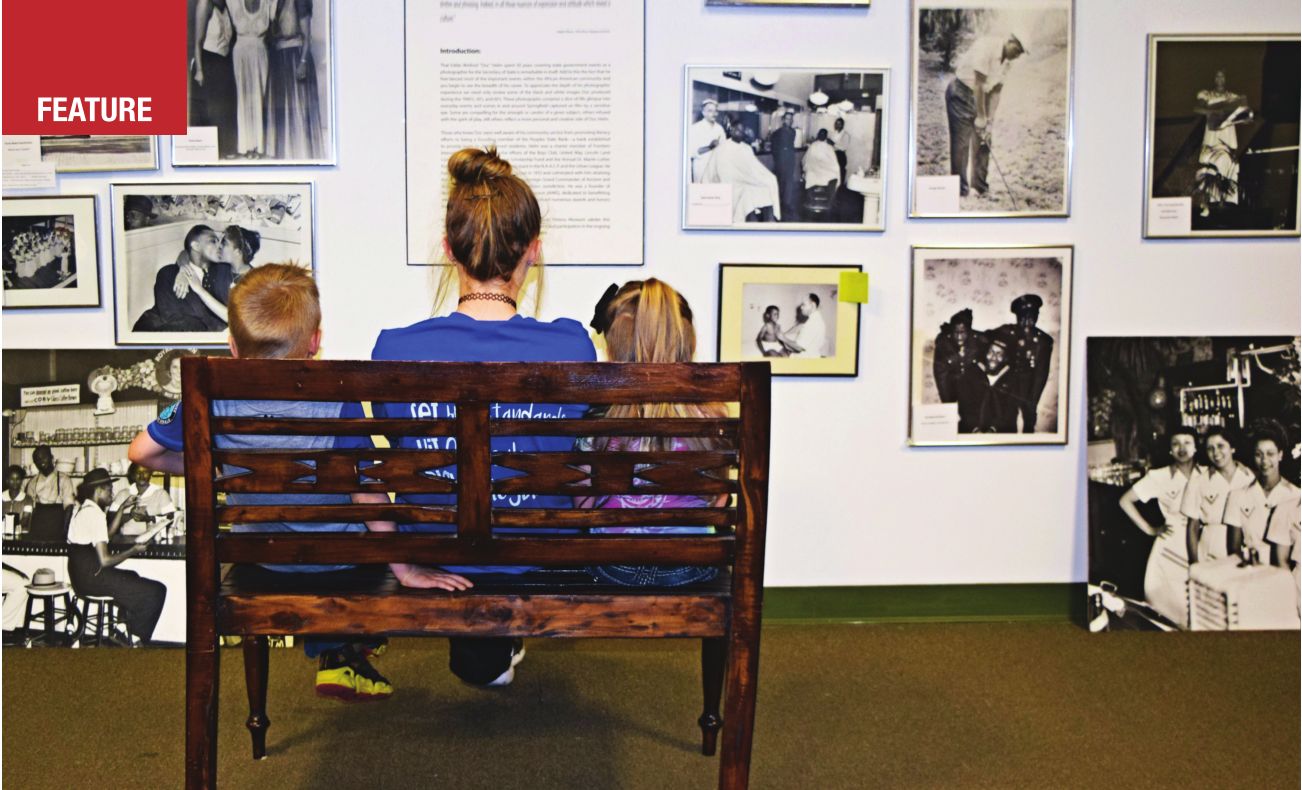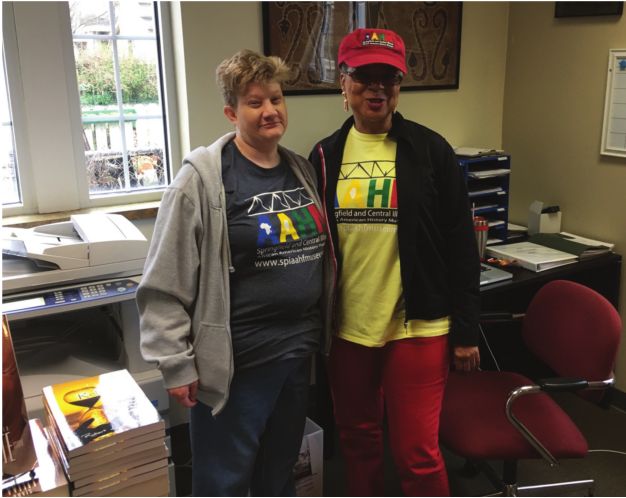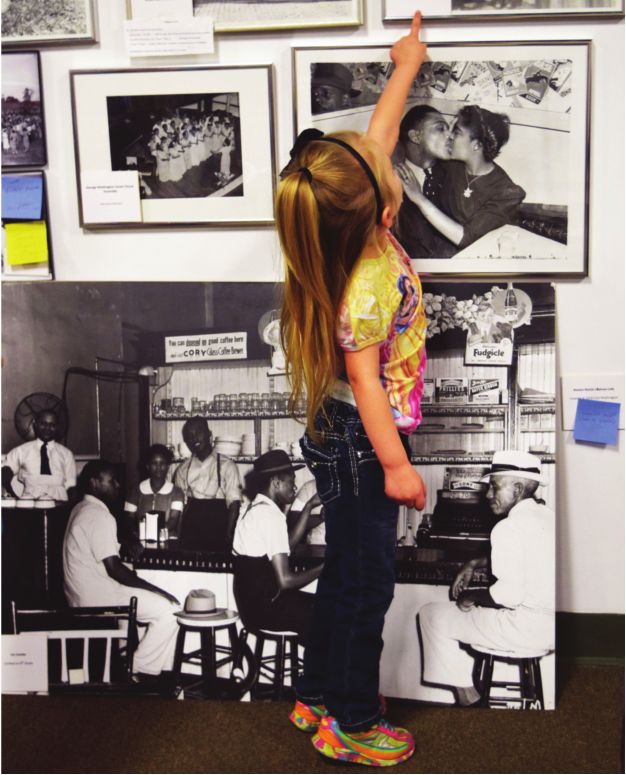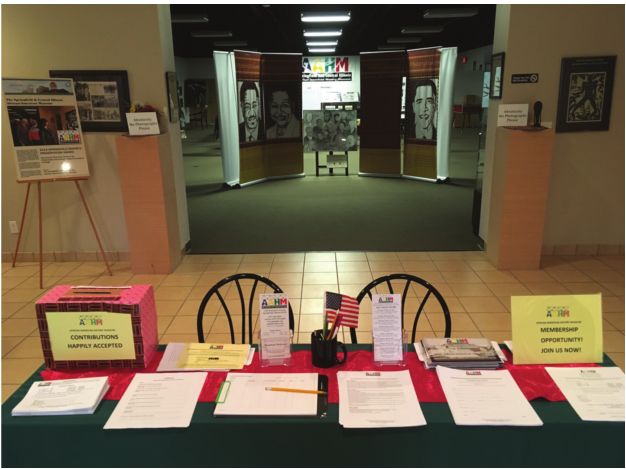
The Springfield and Central Illinois African-American History Museum
On Monument Avenue, next to the main entrance of Oak Ridge Cemetery, the Springfield and Central Illinois African American History Museum sits in view of the Lincoln Tomb State Historic Site. The museum opened on March 3, 2016, and recently celebrated its anniversary by signing a three-year lease with the City of Springfield, owners of the building. After moving through two other locations since its inception in 2012, a full year of exhibits and programs at its third home has the museum focused on central Illinois African-American history, while working toward maintaining the vision of what the organization is and can become.
According to Doug King, the current AAHM board president and interim director, the space is ideal. Over 200,000 tourists annually visit Oak Ridge Cemetery to see the Lincoln Tomb, as well as the Vietnam and Korean War memorials, almost all going right by the front door of the AAHM. The board is busy reaching out to tourism bureaus and businesses, spreading awareness about the location and services of the museum. King envisions buses stopping on a regular basis with the occupants touring the museum before continuing to historic sites within the cemetery, school students visiting on a regular basis for field trips and visitors stopping by just interested in the knowledge and information the museum offers. Not only does the new space allow for buses out front, there’s a goodsized parking lot in back for personal vehicles, along with a front lawn of grass, bushes and trees for a pleasing natural setting.
“We’re very happy to be here. Looking back, it is just the place we need to be,” King said. “Here we’re in a neighborhood with history that we supplement because of who we are.”
Like the old saying goes, you need a base camp before you can climb the mountain. With a secure place to call home, the museum can now concentrate on other portions of their officially stated mission and vision. Many of the goals set in the board’s strategic planning sessions are now being implemented with regularity. Current exhibits include photographs by Eddie Winfred “Doc” Helm, capturing daily life of the black experience in Springfield during the 1940s and 50s, artwork by acclaimed sculptor Preston Jackson and paintings from local artist Olu-Jimi Adeniyi. Last fall the museum landed a visit from the RISE ABOVE Traveling
Exhibit, presenting the story of the Tuskegee Airmen, young black men
learning to be pilots during the segregated time of World War II. The
museum space also allows the group to try for other traveling exhibits,
including ones from the Smithsonian.
Currently,
a good deal of space is allotted to the fascinating tale of Free Frank
and Lucy McWorter. In 1836 Free Frank founded Philadelphia (or New
Philadelphia as it’s now known), the first town in America started by an
African-American. It was located in Pike County near the village of
Barry, not far from the Mississippi River and Hannibal, Missouri. The
town was platted by Free Frank, who purchased himself and most of his
family out of slavery. In a strange twist, his owner was also his
father, who allowed Frank to work for wages, then pay for his own and
his family’s freedom. The integrated town flourished for a time, but in
1869 when the railroad came through the area and didn’t come through New
Philadelphia, the village gradually faded away. Records from an
archaeological excavation of the grounds indicate people may have lived
there into the early 20th century, but for all practical purposes the
town was history by the late 1800s. King said McWorter is as much a part
of the collective community history of central Illinois as Douglas,
Lindsay, Lincoln or Iles, but before the AAHM was established there was
no dedicated space to present the information on a regular basis.
Upcoming events
April 8, 3 to 6 p.m.
A Second Chance Christmas
A festival of culture and cuisine
from around the world
April 22, 1 to 4 p.m.
Escape into a Book with Illinois Authors
May 20, 3 to 5 p.m.
Quilting Exhibit and Demonstration
June 23, 3 to 5 p.m.
Poetry Slam
Oct. 26, 6 to 8 p.m.
Annual Fundraising Gala
Another
display relates local origins of African-Americans with a telling tale
about the first settlers in the area that became Springfield. When John
Kelly came to the area in 1819 and built a shelter near what is now
Second and Jefferson streets, he brought along his family and a boy
known as “Negro Jack.” Three years later, when the young man was eight
years old, Kelly sold him for $300. According to the display, in another
instance of slavery in early central Illinois, around 1827 the Sangamon
County Sheriff auctioned off two women slaves to pay the owner’s debts.
Stories
such as these, along with many more displayed in the exhibits, inform
AAHM visitors of how generations of central Illinois African-Americans
lived and died while contributing to the community. Providing this link
from the past to the present is central to the mission of the museum and
was a force originally bonding the group that eventually formed the
AAHM. King begins the tale of how the organization came to be by saying,
“It all began with a failure.”
About
18 years ago, King and a group of concerned citizens attempted to
purchase a historic building at 427 South 12th Street known as “The
Lincoln Colored Home” or “The Lincoln Colored Old Folks and Orphans
Home” to return it to the residents of the area to use as they needed.
As they began negotiations, the property owner raised the
selling price beyond what the interested parties could afford. The
building was placed on the National Register of Historic Places in 1998,
but is still unavailable to the public, though encouraging things
occasionally happen to preserve the vacant property.
“We
were unsuccessful, but it felt good and we decided to stay together,”
King stated. “Then we wondered, what else could we do?” From there the
group decided to record oral histories of local, elder African-Americans
for posterity. They contacted Cullom Davis, a nationally known oral
historian and professor at University of Illinois Springfield, for help
in achieving this goal. Davis trained the group in how to properly
acquire oral histories, from questions to ask to the equipment needed
for the work. The mission was successful -- the collection of over 700
recordings is now housed at the Abraham Lincoln Presidential Library and
Museum and is available to the public online through the ALPLM website.
By
2006 the group had incorporated into an official organization called
the Springfield African American History Foundation, hosting regular
meetings complete with a board and officers. According to King, a few
years later, during a routine meeting, members were again wondering what
else they could accomplish and hit upon creating an African-American
museum focused on local history. With the many museums and historic
sites already established in Springfield, they realized none were based
on the history of black citizens from the area. After a period of
organizing and planning, the Springfield and Central Illinois African
American History Museum officially opened in February of 2012.
The
first location seemed ideal, housed in a building on the north side of
the Old Capitol Plaza, in a second-story space along with the Illinois
State Historical Society offices, directly above the National Museum of
Surveying and only a block away from the Abraham Lincoln Presidential
Library and Museum. Indeed, things were going well for the fledgling
museum as it worked to expand exhibits and gain exposure, while sharing
building space with the other organizations who were also hoping to draw
visitors looking for something more than just information on Old Abe.
But by 2013 the surveying museum had folded and with that the building
owners decided to sell the property. When the ISHS moved into the
recently restored Strawbridge-Shepherd House on the University of
Illinois Springfield campus, the AAHM followed in 2014. The upstairs
space in the 1850s home left little room for meetings and exhibits and
was off the beaten path for visitors, but the museum was still viable
with a working space and a desire to remain intact.
After
about 15 months at that location the Oak Ridge Cemetery Association
reached out to the museum board with information about the empty
building owned by the City of Springfield on Monument Avenue. Originally
built to house the Museum of Funeral Customs, which closed in 2009, the
building appeared just right for a museum in search of a home. King
explained that as soon as they walked into the building, board members
immediately envisioned how the space could be utilized for their needs.
King credits the Oak Ridge Cemetery Association for paving the way for
negotiations with Mayor Jim Langfelder’s office that led to a signed
lease in December of 2015. After a grand opening and ribbon cutting
event on March 3, 2016, the Springfield and Central Illinois African
American History Museum officially had a new and viable home.
 King
gives credit for all the success to others, explaining as board
president and interim director, he simply serves to guide and help
implement programs as board members and volunteers come up with the
ideas and do the work. The nonprofit museum organization continues to
search for grants and accepts donations, counting on their annual gala
as a major funding experience. The 2017 event is currently scheduled for
Oct. 26 and includes a reception, silent auction, dinner and program.
King
gives credit for all the success to others, explaining as board
president and interim director, he simply serves to guide and help
implement programs as board members and volunteers come up with the
ideas and do the work. The nonprofit museum organization continues to
search for grants and accepts donations, counting on their annual gala
as a major funding experience. The 2017 event is currently scheduled for
Oct. 26 and includes a reception, silent auction, dinner and program.
As
with any organization, but especially one so intertwined with history
and the related topics of race relations and political choices, the
continuing existence of the museum is vitally important to the founders.
With that future in mind, during a recent planning session the board
set a goal of hiring a full-time director. As King explained it, none of
the board members or volunteers really know how to run a museum, even
though they had the drive to establish one. Someone with neutral
feelings about the place and with training in running a similar
enterprise would be very beneficial at this point in expanding the reach
of the facility. King, now in his second term as board president
(former presidents include Rudy Davenport and Jerrie Blakely), would be
freed to work on other museum projects with a full-time director running
day-to-day operations A constant objective of the group is to reach
beyond the museum walls and into the community of central Illinois to
share the knowledge of local African-American history. They’ve traveled
with an outreach program to schools and state agencies and even to the
Taylorville Correctional Center. Each month the museum offers a
different program. In January of 2017 they commemorated the 30th
anniversary of winning the landmark lawsuit that changed how Springfield
elected government officials. February was all about Black History
month and during that time they could barely keep up with the demand for
presentations. They also hosted a program with a descendant of the Free Frank
McWorter family and have plans to do another presentation in connection
with a book signing later in the year. In March they covered National
Women’s History and also produced the first edition of Sojourner, the
AAHM’s newsletter, dedicated to all the happenings at the museum. On
April 8, from 3 to 6 p.m., the museum hosts a Second Chance Christmas,
where “costumed hosts will offer an array of ethnic foods for sampling”
as a fun fundraising event.
“What
we want people to realize is black history is all our history. You
don’t have to wait until February,” King explained. “Every day, every
week, every year is making history that we are a part of and we’re here
to offer help in realizing that and to help us all learn from it.”
A
vital part of the museum’s mission is to establish relations with the
next generation who will hopefully continue the work of the founders.
One of the ways they’ve reached out is by encouraging University of
Illinois Springfield students to become interns at the AAHS. Aaron
Pearl-Cropp, who went back to college in his 40s, began his involvement
with the museum through a UIS requirement that all students do community
involvement projects before graduating. He didn’t know much about the
AAHM when he began his internship, but now Aaron sits on the 21-member
board, a firm believer in the power of the museum to educate and inform
the public on the history of African- Americans in central Illinois.
“This
is a jewel right here. At the end of the day these are the stories and
the lives of those who have helped to build Springfield,” he said. “This
is history. There are thousands of people going right by the museum
every day and we need to connect with them and expose them to this.”
Aaron
praised the dedication and vision of Doug King and tries to emulate
King’s commitment to the cause of the museum. During his childhood,
Pearl-Cropp’s mother worked as a janitor at Sangamon State University,
the predecessor of UIS. He graduated from the university in 2016 with a
bachelor’s degree in Business Administration. He was also involved in
the early desegregation of District 186 schools, getting bused from
Matheny to Jane Addams in third grade, living through that part of
history in real time. He spends a good deal of his volunteer hours
working with grade school-age kids, explaining how the education and
knowledge the museum offers can teach them about their own history and
thereby helping to better understand their own presence in the world.
As
Doug King and other board members continue to push forward with the
mission and vision of the museum, plans include fully participating in
the Illinois Bicentennial in 2018, reaching out to other African-
American museums around the state and the nation, boosting the presence
of the AAHM in the local community and mostly, being thankful for
helping others understand the rich and vibrant history of African-
Americans in central Illinois and how our future can be bettered by
studying our past.
“God has truly blessed us in the short time we’ve been here,” King said. “It’s been amazing.”
Tom
Irwin, a lifelong central Illinois resident and musician, is a history
buff who greatly appreciates the contributions of African- Americans to
the world of music and beyond. Contact him at [email protected].